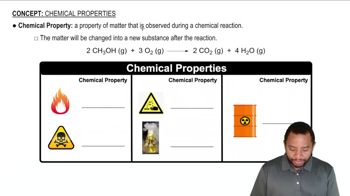Sulfuric acid is a component of acid rain formed when gaseous sulfur dioxide pollutant reacts with gaseous oxygen and liquid water to form aqueous sulfuric acid. Write the balanced chemical equation this reaction. (Note: this is a simplified representation of this reaction.)
Ch.4 - Chemical Reactions and Chemical Quantities

Chapter 4, Problem 16
When iron rusts, solid iron reacts with gaseous oxygen to form solid iron(III) oxide. Write the balanced chemical equation for this reaction.
 Verified step by step guidance
Verified step by step guidance1
Identify the reactants and products: The reactants are solid iron (Fe) and gaseous oxygen (O_2), and the product is solid iron(III) oxide (Fe_2O_3).
Write the unbalanced chemical equation: Fe (s) + O_2 (g) \rightarrow Fe_2O_3 (s).
Balance the iron atoms: Since there are 2 iron atoms in Fe_2O_3, place a coefficient of 2 in front of Fe: 2Fe (s) + O_2 (g) \rightarrow Fe_2O_3 (s).
Balance the oxygen atoms: There are 3 oxygen atoms in Fe_2O_3, so place a coefficient of 3/2 in front of O_2 to balance the oxygen atoms: 2Fe (s) + \frac{3}{2}O_2 (g) \rightarrow Fe_2O_3 (s).
Convert to whole numbers: Multiply the entire equation by 2 to eliminate the fraction: 4Fe (s) + 3O_2 (g) \rightarrow 2Fe_2O_3 (s).

Verified video answer for a similar problem:
This video solution was recommended by our tutors as helpful for the problem above.
Video duration:
1mWas this helpful?
Key Concepts
Here are the essential concepts you must grasp in order to answer the question correctly.
Chemical Reactions
A chemical reaction involves the transformation of reactants into products through the breaking and forming of chemical bonds. In the case of rusting, iron (Fe) reacts with oxygen (O2) to produce iron(III) oxide (Fe2O3), illustrating how elements combine to form new compounds.
Recommended video:
Guided course

Chemical Properties
Balancing Chemical Equations
Balancing a chemical equation ensures that the number of atoms for each element is the same on both sides of the equation, adhering to the law of conservation of mass. This process involves adjusting coefficients in front of the chemical formulas to achieve balance, which is crucial for accurately representing the reaction.
Recommended video:
Guided course

Balancing Chemical Equations
Oxidation-Reduction Reactions
Rusting is an example of an oxidation-reduction (redox) reaction, where iron is oxidized (loses electrons) and oxygen is reduced (gains electrons). Understanding the transfer of electrons in these reactions helps explain the chemical changes occurring during rust formation and the role of oxygen in the process.
Recommended video:
Guided course

Oxidation and Reduction Reactions
Related Practice
Textbook Question
1
rank
Textbook Question
Nitric acid is a component of acid rain that forms when gaseous nitrogen dioxide pollutant reacts with gaseous oxygen and liquid water to form aqueous nitric acid. Write the balanced chemical equation for this reaction. (Note: this is a simplified representation of this reaction.)
1
rank
Textbook Question
Write the balanced chemical equation for the fermentation of sucrose (C12H22O11) by yeasts in which the aqueous sugar reacts with water to form aqueous ethanol (C2H5OH) and carbon dioxide gas.
Textbook Question
Write the balanced chemical equation for each reaction. a. Solid lead(II) sulfide reacts with aqueous hydrobromic acid to form solid lead(II) bromide and dihydrogen monosulfide gas.
